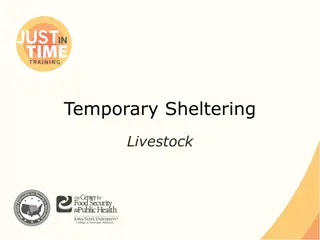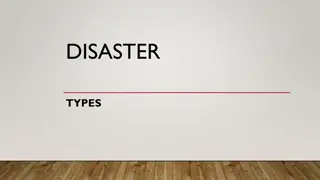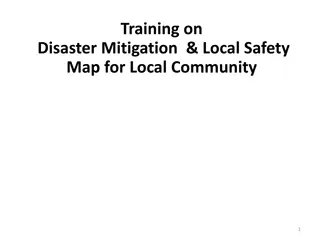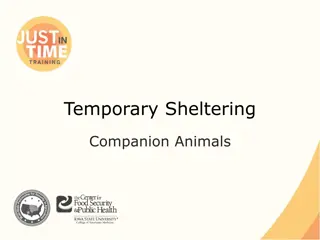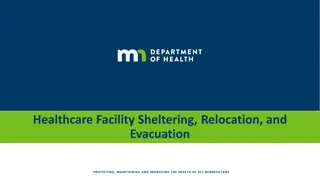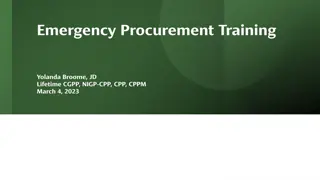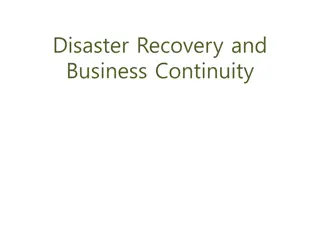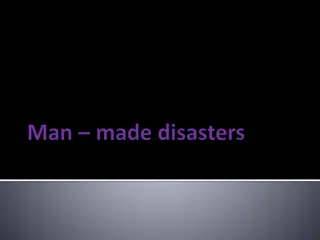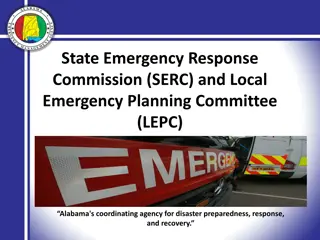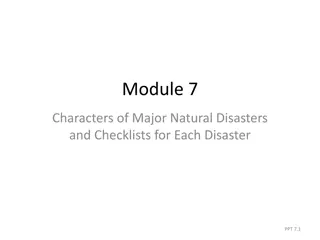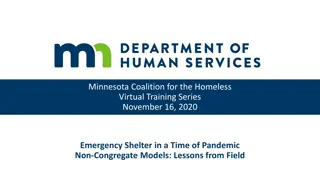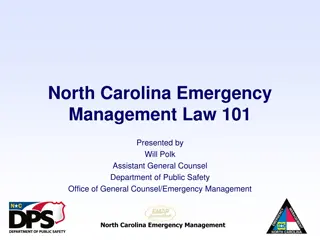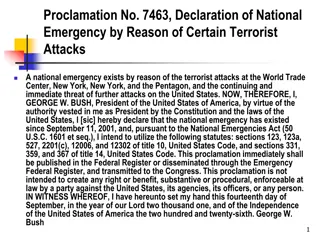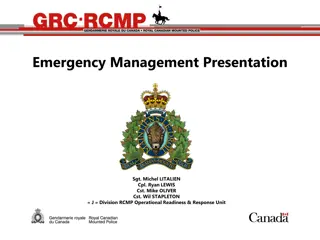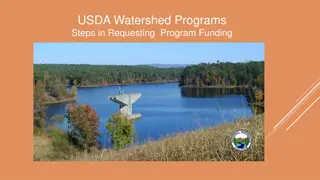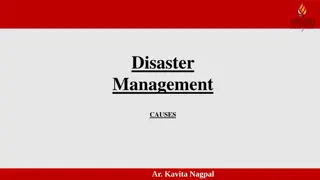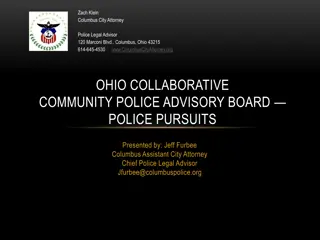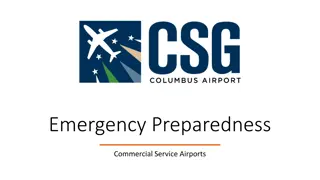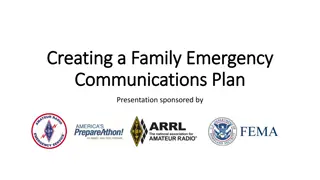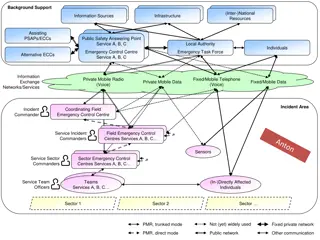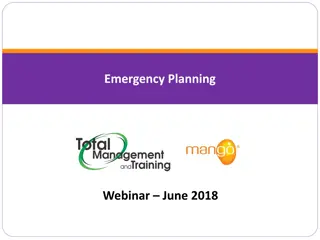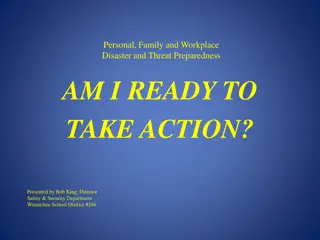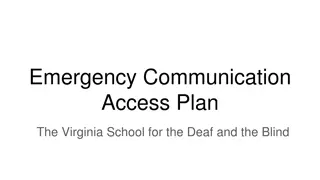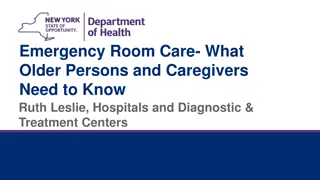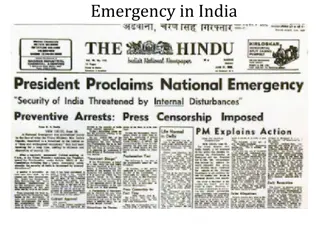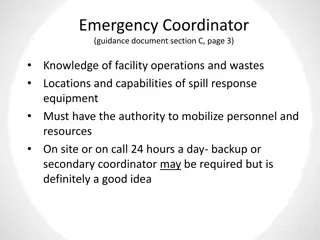Emergency Sheltering and Safety Tips for Disasters
Know what to do in an emergency - whether to evacuate or shelter in place. Practice tornado and fire safety plans with your family. Learn about storm shelters, sheltering guidelines for tornadoes and hurricanes, differences between tornadoes and hurricanes, and emergency evacuation shelters. Stay informed and prepared to keep your family safe in times of disaster.
Download Presentation

Please find below an Image/Link to download the presentation.
The content on the website is provided AS IS for your information and personal use only. It may not be sold, licensed, or shared on other websites without obtaining consent from the author. Download presentation by click this link. If you encounter any issues during the download, it is possible that the publisher has removed the file from their server.
E N D
Presentation Transcript
Why shelter? In a disaster you may be asked to either evacuate or shelter in place. In the excitement of an emergency it can be difficult to focus on what you are doing. Know what to do to keep your family safe. Practice tornado and fire safety plans. If your family has practiced they will be more comfortable doing it when the emergency actually happens.
Choose one thing to do this month 1. Identify the best storm shelter in your home and practice getting to the shelter with your family. 2. Learn how to safely shelter in place. 3. Make a Go Bag for emergency sheltering.
Storm Shelter Guidelines Tornado x Hurricane x Put as many walls between yourself and the outside as you can Go to the lowest safe level (winds are stronger at higher levels) Close all interior doors Shelter under a table or other sturdy object Stay away from glass (even interior windows or glass fronted cabinets) Don t use elevators Get underground if possible Leave mobile homes or portable buildings to go to a safer location Close blinds and curtains, cover windows with shutters if possible x x x x x x x x x x x x x x
Tornado vs. Hurricane Tornadoes happen with much less warning than hurricanes. Don t take the time to close (or open) windows or doors once a tornado warning is issued. Take shelter immediately. Although both storms typically come with rain, hurricane rains are much heavier. Underground areas are prone to flooding, which can be as dangerous as the wind.
Emergency Evacuation Shelter Emergency evacuation shelters are typically opened by the American Red Cross, the Salvation Army, or a government agency.
Shelter in Place Stay inside until the danger has passed May be notified by outdoor warning sirens or Emergency Alert radio (also called NOAA Weather Radios) Always follow emergency instructions
Important! Never call 911 to get information in an emergency Only call 911 when you need police, fire, or emergency medical assistance
Practice makes perfect Talk to your family about your tornado shelter area. Make sure they know when and why to take shelter. Practice getting to the area quickly. Don t forget pets if you are planning to bring them in a tornado warning. Practice staying in your tornado shelter area for 10 minutes to see if any problems arise.
Make a Go Bag Take your Go Bag with you to the shelter area inside your home if you have to shelter in place. Take your Go Bag to the emergency evacuation shelter if you have to leave your home in a disaster.
Emergency Evacuation Shelters Usually Provided Cots for sleeping Meals and bottled water Nurse for basic medical care Information from public officials You Should Bring Pillows and blankets Change of clothes Medication and medical supplies Comfort items, magazines, cards, etc. Identification NOT ALLOWED Weapons Alcohol Animals (except for service animals) Shelters will usually not share your personal information with anyone, including the fact that you are safe at the shelter, unless you give them permission.
Go Bag Items Medical Supplies Comfort Items Books and magazines Cards Coloring books and crayons Toys Chargers for phones or tablets Medication list with dosage, pharmacy name, and prescribing doctor Doctors names and phone numbers Medical supplies (catheters, insulin syringes, etc.) Extra assistive devices (glasses, hearing aids, canes, etc.) Batteries or chargers for assistive devices General Change of clothing for each family member Flashlight and extra batteries Emergency information (including insurance policies) Toothbrushes and toothpaste Non-perishable snacks Lightweight blankets Battery powered radio Bottled water Identification Drivers license or other photo ID Photo IDs or copies of birth certificates for family members Photos or microchip ID information for pets
Go Bag Items Don t forget to include specialty items for specific family members
Next Month In a disaster you may not be able to get to the store. You may not have a stove or microwave for cooking. Having an emergency food supply ready doesn t have to be hard or expensive. Find out how to make sure your family (including your pets) will have what they need when disaster strikes.
For more information Presenter s name Contact Information Contact Information Do 1 Thing http://www.do1thing.com Email: contact@do1thing.com


